Holidays with hubby are very different to solo adventures. Five star hotels, afternoon naps, sleep ins, and no guilt about not ramming the day with tourist activities. We are in Ladakh for a relaxed week visiting monasteries and seeing the famous Hemis festival before hubby heads home and I go hiking.
Getting to Ladakh isn’t straightforward. Eight hours from London to Delhi, then an overnight before taking the 90 minute flight to Leh. Much easier than 30 years ago when it was a 24 hour bus trip. Landing in Leh is a little taxing as the town is at 3500m so everyone feels a little bit breathless. We had a lazy afternoon at the delightful chospa hotel and then had some excellent experience of Indian bureaucracy getting a SIM card. Given the regions difficulties with their neighbours (Pakistan and China), both foreign sims and sims from outside of jammu, Kashmir and Ladakh are blocked so we spent two hours chatting to other tourists while we waited for a SIM card (he processed one every 30 minutes). After that a very spicy dinner at a cheap local restaurant and a terrible jet lagged sleep
Leh Palace
We slept in the next day eventually rousing ourselves to go and be good tourists. First up we meandered to Leh Palace which is an imposing structure visible from most of Leh, but actually very small from within the very thick walls (and heaving with Indian tourists :-)). It was nice, but the dust was blowing fiercely on the upper terraces.







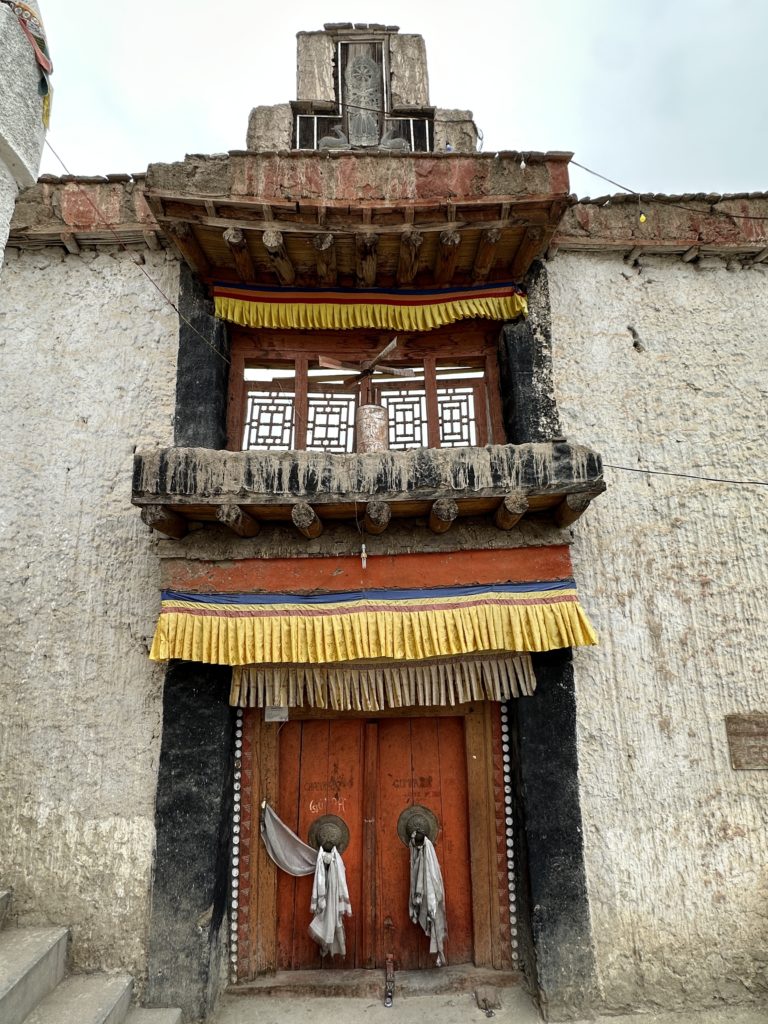



Scrambling up to Tsemo Fort
We then decided to hike up to the Tsemo Fort (most visitors drive around), and we took a slight detour which turned into a more technical ascent than I was expecting with both hands required to ascend a slanted rock chimney. The views were stunning though, and we got engulfed by prayer flags as we came over the ridge line. The fort was pretty quiet, and the attendant was keeping herself busy watching very loud soap operas on her iPhone. It was a rainy day but the views out over town were still worth the climb.
We wandered back down the hill and had lunch at Lamayuru restaurant. Effectively every restaurant in Leh has pretty much the same menu but the view changes. They all sell Indian, Chinese and Tibetan specialties – I am already craving meat and vegetables, but it is nice to get curd, momos, dahl and some thenthuk. We contemplated being good tourists and going to see the Shanti stupa but opted instead for a nice stroll around town, an afternoon nap, followed by some shopping at the excellent Jigmat couture, and then dinner at the Tibetan kitchen (apparently the best in town, but the same menu as everywhere else). The oddest part of our day was the Tibetan Refugee market where 90% of the products were obviously cheap chinese souvenirs – the irony did not escape us.















Lunar landscapes at Lamayuru
The excellent Skalzang from Rimo expeditions met us with our lovely driver mubashir at 8am to start our day. We had contemplated going rafting but decided it wasn’t warm enough and we would rather not rush around the sites that afternoon – but for anyone who is keen, there are multiple rafting options down the Zanskar river. The landscape outside of Leh is stunning – very very similar to the scenery in Gilgit and the Hunza Valley in Pakistan which we visited last year, but with architecture and people very similar to Bhutan and the upper Mustang. Its delightful.
Our first stop (apart from some view points) was the Lamayuru monastery – the first of many. Its a beautiful building with some lovely prayer wheels, with an even better view down to a spectacular green valley and a weird lunar landscape. No pictures allowed inside the temple, but there were some wonderful buddha carvings, and I always have a chuckle at the six packs of Coca Cola in the offering assortment.













World class Frescos at Alchi monastery
After a quick cup of chai, we headed back to Alchi monastery. We arrived at lunchtime, which was perfect, as we had Tain Tain, Khambir, Chutargi and local saffron yogurt and apricots at the excellent Alchi Kitchen – run entirely by women in an open kitchen. It was delicious.
Fortified, we wandered down to the monastery, overtaking lots of local Indian tourists who were entranced by the ‘artefacts’ for sale (which we were pretty sure had all been made in China and shipped in), and we properly circumnavigated the monastery spinning all the wheels (good karma and plus we got a nice view of the Indus River). Photography isn’t allowed inside the monastery walls (phones and cameras must be stored in external lockers), but the frescos in the four main temples were some of the nicest I have ever seen – stunning. I would highly recommend a visit.






Chilling out like royalty at Nimmu House
We felt like we had been good tourists for the day, and it was 3pm, so we headed to our destination for the evening – the lovingly restored Nimmu House, which has just four heritage rooms inside (and five tents in the garden). The orchard garden was divine. It is owned by a relative of the former royalty and managed by a largely local team. Dinner was a little underwhelming – we had to order more – but everything was made from their garden and it was nice (I just struggled a little with the absence of protein). We went to bed to find hot water bottles had been put in at turn down service – delightful – and we had a tea and went to sleep.



Heating up at the Hemis Festival
We had the sleep of champions and I finally woke up at 8am feeling very chuffed to get a good night sleep. Breakfast was a delicious ensemble of home made curd, fried eggs, garam flour pancakes and lots of milky coffee and then Mubashir arrived to drive us to Hemis. The scenery was as spectacular as it was yesterday, and we stopped for a few photos and then picked up our guide for the next couple of days (Rexin) in Leh.
The road up to the Hemis monastery was full of parked cars and locals. Mubashir dropped us off and we wandered up the steep path, marvelling at the games on offer – yup, the same as when we were kids – throw the ring over the prize, and knock over the cups – and the energetic poker games underway. We paid for our tickets and then threw ourselves into the fray to try and find a good vantage spot to watch the dancing. We spent the first hour or so on the terrace looking down, amused by the foreign tour groups who had prebooked chairs (we are not that organised), and we did manage to borrow a chair for a 30 minute sit down. The dancing was lovely – the monks having practised for months, and the masks were spectacular.
After the lunch break we went and scored ourselves an excellent spot on the ground next to a large group of ladies from the neighbouring Shey village. Our guide, in the meantime, procured us a spare lunch box from one of the big tour groups in case we were hungry. We promptly redistributed our lunch around our new friends from Shey, and they kept me cool by including me in their umbrella shade. They were also most amused by my new found Ladakhi words.
After four hours, we were pretty cooked, but the dancing was lovely and I am now definitely buying myself a mask with skulls on! The atmosphere was lovely and while it was super crowded, it was also largely local, and very chilled out.
We are staying at Saboo Resort – in a quiet spot just outside of Leh tonight so it will be easy to visit some nearby monasteries the next day. It is a little haphazard – we have a suite, but you can only get wifi in one of the corners of the room. Quite amusing. A good dinner of chapatis and curry and an early night




























Stakna Gomba
We started our day with spicy chili omelettes, dhokla (a lovely gujarati bread) and lots of coffee and then headed off to the majestic Stakna Gompa – so named as it looks like a leopard’s nose. It is a stunning gompa perched on a hill in the middle of the valley surrounded by greenery. It is a small monastery, with 30 monks from the red hat school. We were the only visitors and the sole monk in attendance was lovely. We were allowed to take photos (no flash) of the many exquisite paintings, and Rezin gave me a brush up on the wheel of life – one of my favourite buddhist images.













Tantra at Thiksey
Next stop, Thiksey, one of the more famous and more visited of Ladakh’s monastery. We were less than thrilled to arrive at the same time as 30 Lithuanian guys on motorbikes, none of whom seemed aware you were supposed to circumnavigate clockwise, and one of whom decided to go into the temple eating an icecream. Rude!!! Ladakhis are famously polite, so noone would point out the bad manners, but it seemed bizarre to me as I can’t imagine going into any religious holy site eating…., oh well. The temples were lovely, and the Maitreya buddha (image of the future buddha) was probably the nicest we had seen so far. I also liked the temple with the black faced protectors whose faces are shrouded for most of the year. I also learnt more about the tantric depictions which were pretty saucy. Will leave you to figure out what I mean from the pictures. Also amusing to note the very similar forms of the paintings to the dancers from Hemis.











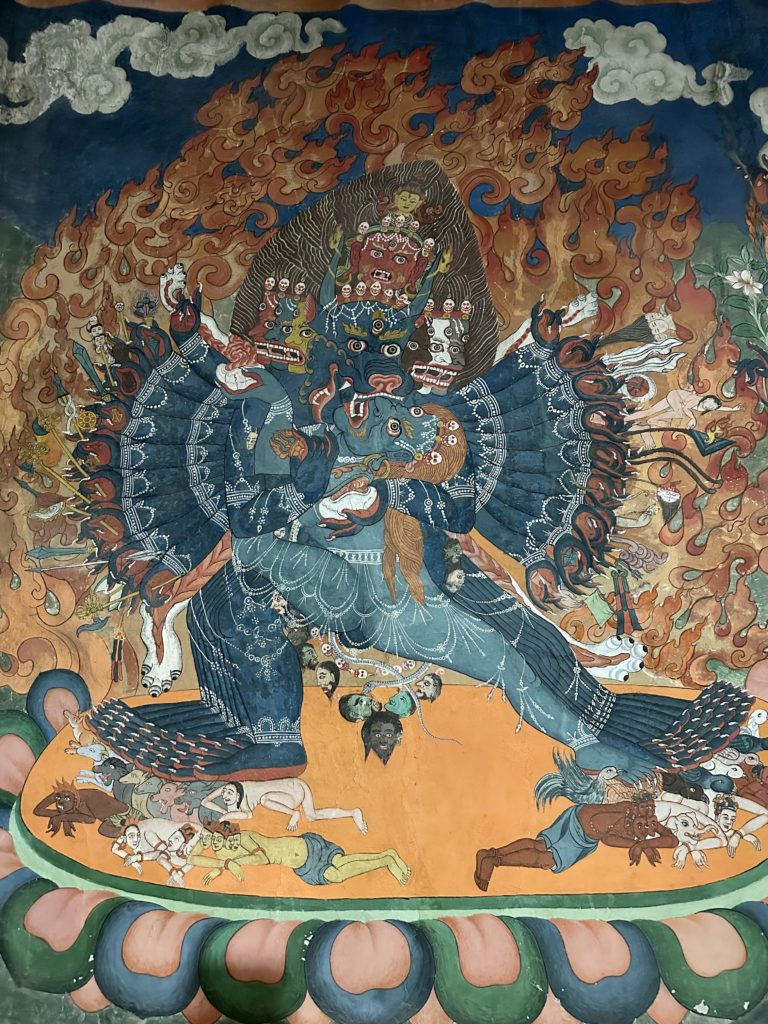









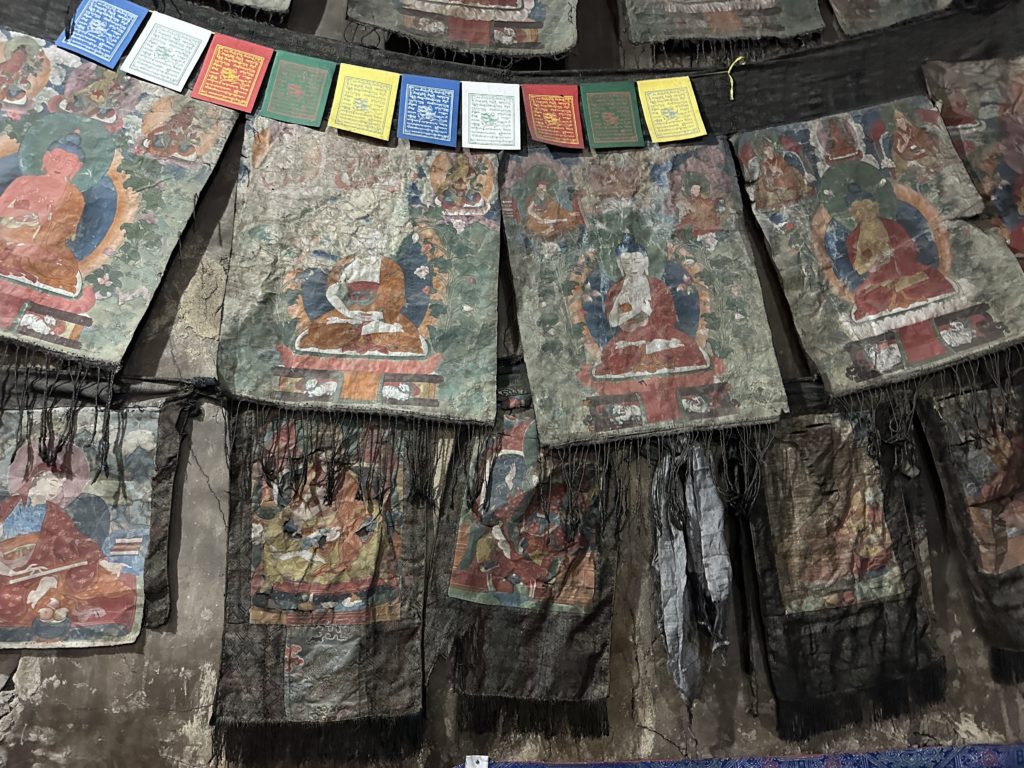




Copper Buddha at Shey Palace
And we ended our day at Shey – original home of the first King of Ladakh (the royal family are still around but reside in Stok). The palace has the only copper buddha in Ladakh and some lovely rock carvings. After that a dust storm had blown up so we retreated to the Saboo for a late lunch, an afternoon nap and more curry for dinner







Wild route over the Wari La
We were heading to the Nubra next, and most people go out and back via the Khandar La at 5600m- which the locals claim is the highest motorable pass in the world. We will come back that way, but we decided to take the long way round and go to Nubra via the Wari La, a little used road going up to 5300m (and probably a three hour longer drive). We backtracked down towards Hemis and then turned up the hill. The road was narrow but decent all the way up to the pass, in long, broad switchbacks. Apart from the road crew we didn’t see anyone once we past the last village. The pass was a little more entertaining, as there was still snow and the road was a proper 4wd bump fest. The views from the top were glorious with vast skies.
On the way down we amused ourselves spotting fat marmots – more than I have ever seen in one day – probably 100 or more, and they were super playful. We also amused Mubashir by stopping to try and take cool photos of the windy road (without much success). We reached the bottom about noon and having had a very quiet morning, were taken aback to arrive in the tiny settlement of Agham (four thriving tea houses) to find about 60 motorcyclists and a lot of domestic tourists. There is nothing between Diksit and Agham, and nothing between Agham and Pangong Lake (further south), so it is a popular stop. The vast majority of the motorcyclists were not the leanest (the Spaniards in particular were busting out of their jeans and motorbike pants), and they were chaperoned by a guide and a 4wd, so I doubt it was the wild adventure they were contemplating when they were googling from their couches. But it was funny to watch them not be able to start their bikes.
We stopped for chai and paratha. Pangong Lake is a tough road, but very very popular with Indian tourists as a famous movie was made there. We weren’t going as didn’t have permits, and didn’t fancy the road. But we were most amused on the next 90 minutes towards Diskit that every domestic tourist (in huge 4wds or on motorcycles with not quite the right gear) flagged us down to make sure they were going the right way. Mubashir was very patient, I was less so – directions are why google maps exist.
We did have to take a further detour as one of the roads is being rebuilt, but arrived at the (not quite as glamorous as the website made it out to be) Stone Hedge Hotel in Nubra at 2.30pm feeling pretty dusty. I contributed to the economy by having an excellent deep tissue massage, and then dinner (a crazy expensive and not particularly good buffet).





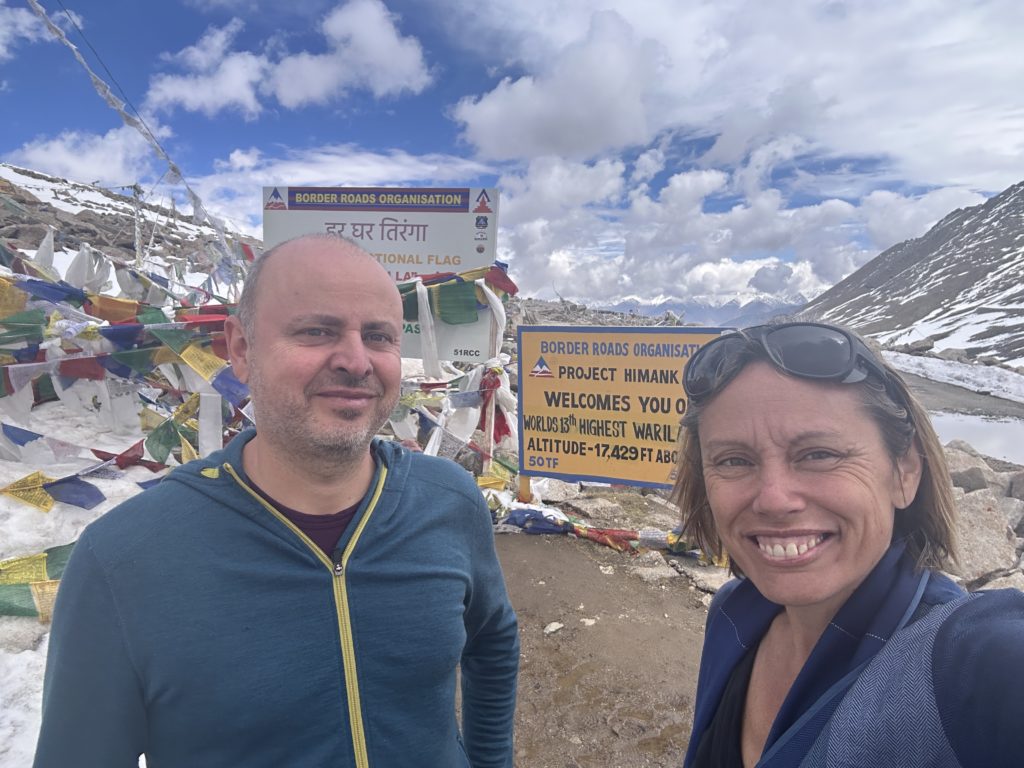










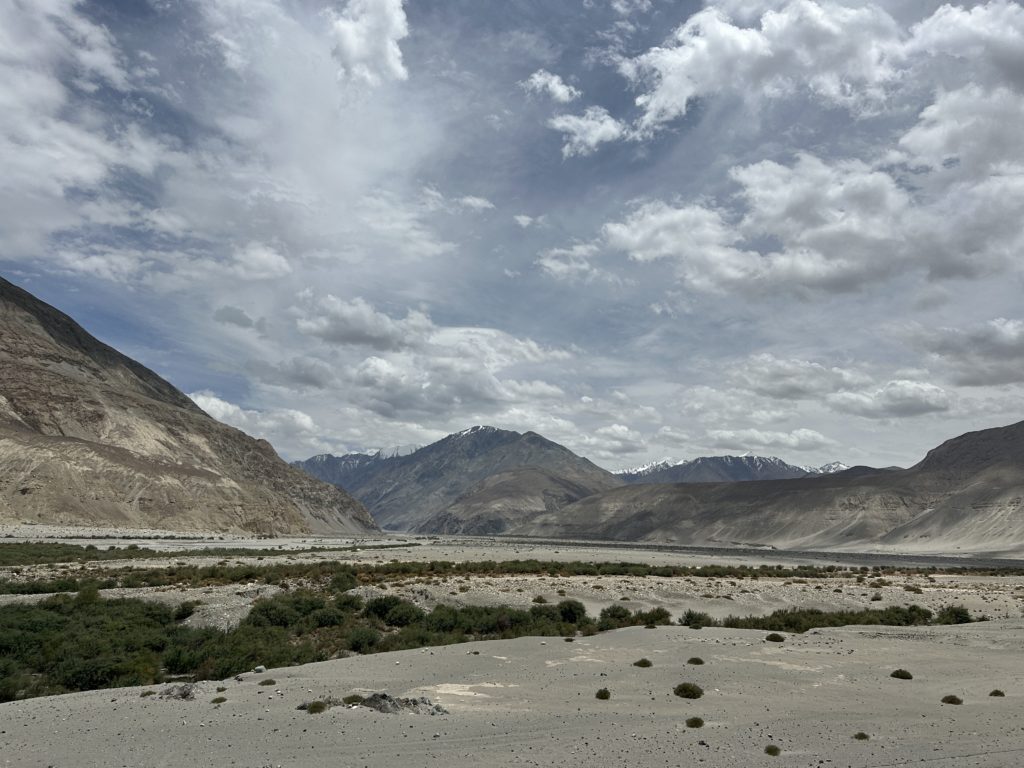




Chatty visit to Samstanling
Most of the foreign tourists who have extra time in the Nubra valley head to Turtuk – not because there is anything much to see (its a small muslim village), but because it is the furthest foreigners can go towards Pakistan and the line of control. Given hubby and i have travelled extensively in Northern Pakistan just across the border, we decided instead to have a leisurely day visiting some more monasteries and spinning some more prayer flags. We headed north up the Nubra river to Samstanling monastery which had lovely monks who were very friendly. Hubby and I have both been working on our Ladakhi phrases and know how to appropriately address a monk, and in return, they often chat. It was a lovely quiet monastery with views out over the confluence of the Nubra and the Shyok river









The big monastery at Diskit
Diskit not Dikshit, I keep reminding myself. We were staying not far from Dkisit in Hunder. This entire area is wildly popular with Indian tourists who come to take camel rides on the dunes (we didn’t), take the zipline (missed that), ride an ATV in the gravel (passed on that), and stay in a tent. They also visit the monasteries, but not all of them. Our driver and us were very amused by the lack of fitness, combined with the complaints about having to walk uphill to see the temples. These tourists have very fancy sneakers, but not quite the legs to take them up stairs. Diskit was lovely, and while the buddha was well visited, the very steep climb to the monastery meant we virtually had it to ourselves. The monks even gave us a cup of tea – excellent pink ladakhi tea with milk, butter and salt – i like it, hubby had a tetley. We were done touristing at around 3pm, so stopped in ‘town’ for a thali – which expensive at £2.50 (everything is expensive up here given the transport links), was a lot cheaper than our hotel restaurant.


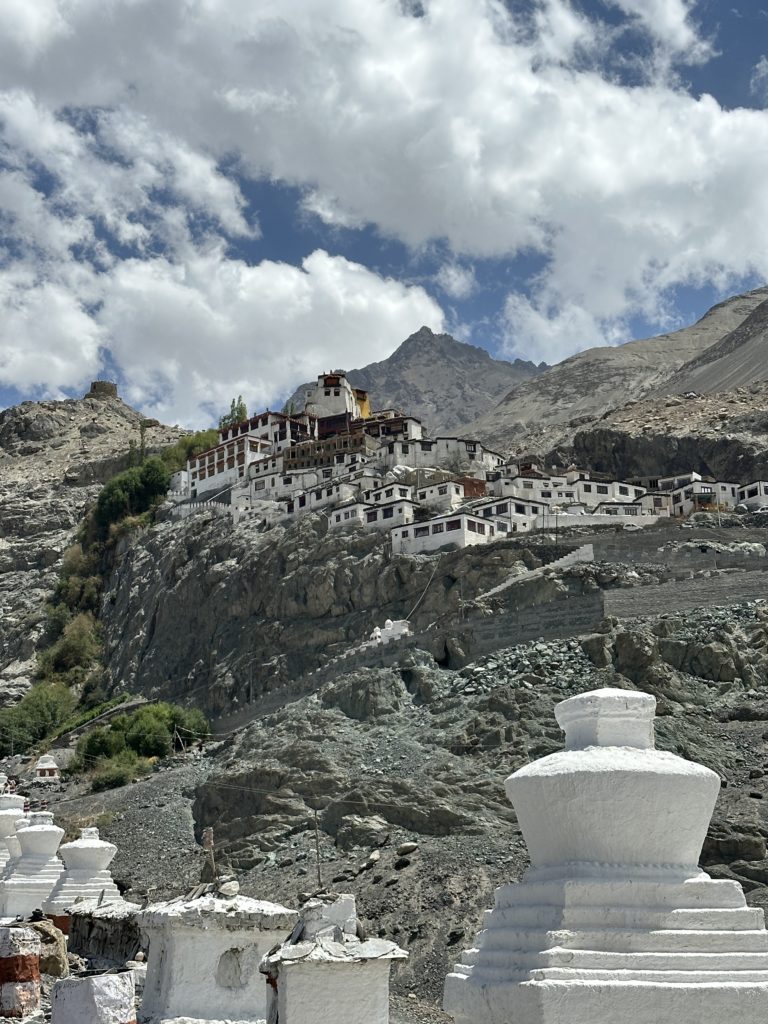












Nubra valley views
Driving between the monasteries and around the Nubra was lovely. Apart from the stunning scenery, the additional joy from driving in Ladakh is the vast number of road signs counselling sensible driving. Here is a small selection of the sign content, made me chuckle
Stay married, divorce speed
Don’t watch her behind
Better late than never
Live for your today drive for your tomorrow
Time is money but life is precious
Look everyway everyday
Don’t be silly in the hilly
Be mr late than late mr
This is not rally or race drive with grace
Peep peep don’t sleep
After whiskey driving risky
Fast drive could be last drive
Be soft on my curves
Take heed don’t speed
Speed thrills but kills
Don’t be a gama in the land of the lama
Driving faster can cause disaster
Feel the curves don’t hug them
Don’t lose your head to gain a minute, you need your head your brains are in it
Life don’t have rest button drive safe
Drink and drive you don’t survive
Driving faster can cause disastrous
Fast and furious makes you injurious
If you sleep your family will weep
Drive like hell and soon you will be there
Darling I like you but not so fast
Accidents bring tears safety brings cheers
At cat has nine lives but not the one who drives
If you love god then pray, if you want to meet him drive fast
Life is short don’t make it shorter





Cycling down from Khardung La to Leh (5400m to 3600m)
After another haphazard breakfast at our hotel in Nubra, we headed back to Leh over the Khardung La pass which the locals claim is the highest motorable pass in the world. For extra entertainment I had arranged to pick up mountain bikes at the top to cycle (well it isn’t really cycling as you don’t really have to pedal) the 35km down to Leh, which was pretty much 100% descending. It was actually safer than it sounds, and most of the traffic that overtook us was polite. Hubby, having grown up mountain biking, fared much better than I did on the off-road, bumpy sections. I also couldn’t really feel my fingers for the first 45 minutes as it was snowing at the top. But it was a fun way to return to town – highly recommended









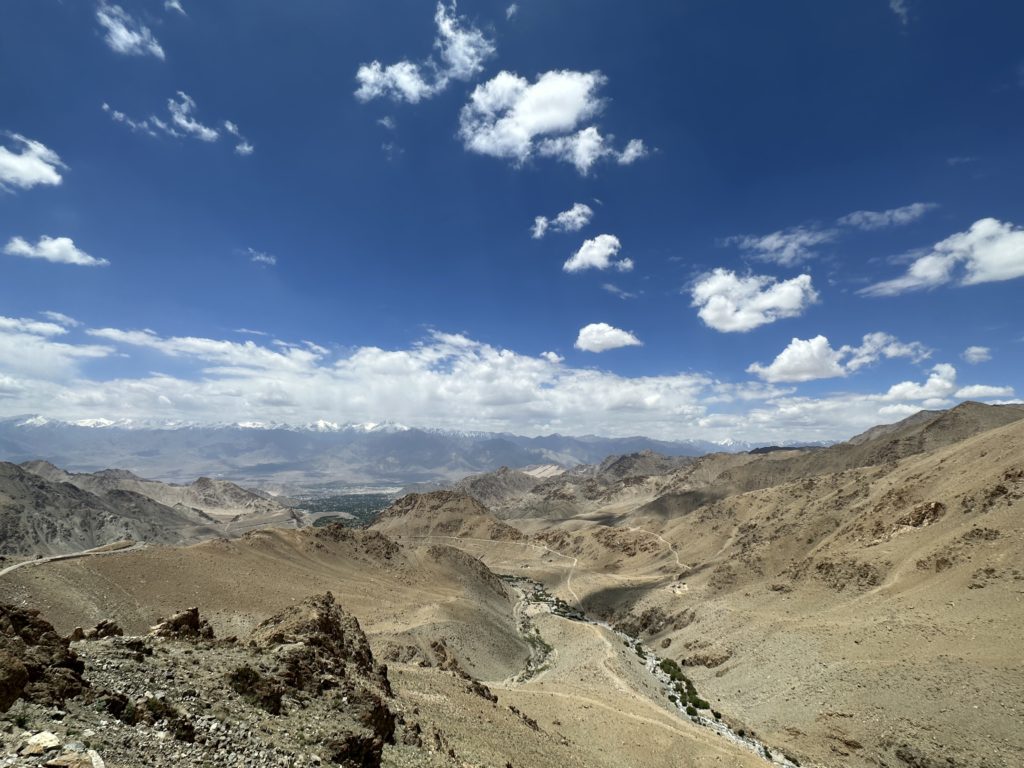



That is the end of the loafing holiday. Hubby is heading back to London via Delhi tomorrow, and I am putting my pack on to trek up the Markha valley. More later…..
2 July, 2023
Additional info
Hotels are quite expensive and not of the standard of elsewhere in India. Saboo Resorts (near Leh) and Stone Hedge Nubra (Hunder) were ok, but did not remotely resemble their web sites. Chospa was pretty nice in Leh, lovely decoration and super friendly staff and very close to town. Nimmu House was a divine building but the food was a bit meh.
Food generally was a bit tedious. Every restaurant sells ladakhi, chinese, indian and western food – the menus are exactly the same. The north and south indian food is about 50% as good as it is in their home regions. The Ladakhi food is nice, but it gets a bit same-y and there is a real dearth of protein and vegetables (what I prefer to eat). I am craving steak and broccoli.
Booked a driver and car through Rimo Expeditions – again this was c. 60% more expensive than I paid elsewhere in India. Mubashir – our driver – was brilliant. Rezin was also an excellent guide and taxi service, he can be reached on +919622996469
I’m really missing Ladakh these days (wasn’t it supposed to be Easter in London?) and this blog is a nice reminder of what a great place it is. I really liked Stakna gompa too, even though on the way there I was chased by a dog and a cow and had to find refuge in the Ayatollah Khomeini youth centre!
Thanks for jotting down those great one-liners from the Indian public safety bureau, the only one I can remember was “Donate blood… not on the roads”.